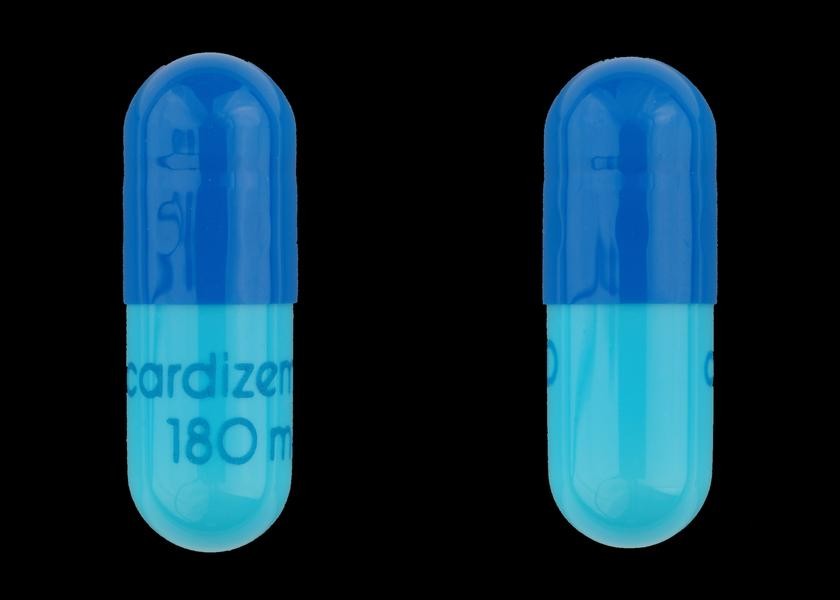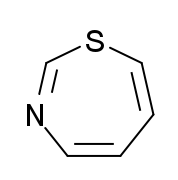|
ATC Code C08
C08C Selective calcium channel blockers with mainly vascular effects C08CA Dihydropyridine derivatives :C08CA01 Amlodipine :C08CA02 Felodipine :C08CA03 Isradipine :C08CA04 Nicardipine :C08CA05 Nifedipine :C08CA06 Nimodipine :C08CA07 Nisoldipine :C08CA08 Nitrendipine :C08CA09 Lacidipine :C08CA10 Nilvadipine :C08CA11 Manidipine :C08CA12 Barnidipine :C08CA13 Lercanidipine :C08CA14 Cilnidipine :C08CA15 Benidipine :C08CA16 Clevidipine :C08CA17 Levamlodipine :C08CA51 Amlodipine and celecoxib :C08CA55 Nifedipine, combinations C08CX Other selective calcium channel blockers with mainly vascular effects :C08CX01 Mibefradil C08D Selective calcium channel blockers with direct cardiac effects C08DA Phenylalkylamine derivatives :C08DA01 Verapamil :C08DA02 Gallopamil :C08DA51 Verapamil, combinations C08DB Benzothiazepine derivatives :C08DB01 Diltiazem C08E Non-selective calcium channel blockers C08EA Phenylalkylamine derivatives :C08EA01 Fendiline :C08EA02 Bepridil C08EX Ot ... [...More Info...] [...Related Items...] OR: [Wikipedia] [Google] [Baidu] |
Calcium Channel Blocker
Calcium channel blockers (CCB), calcium channel antagonists or calcium antagonists are a group of medications that disrupt the movement of calcium () through calcium channels. Calcium channel blockers are used as antihypertensive drugs, i.e., as medications to decrease blood pressure in patients with hypertension. CCBs are particularly effective against large vessel stiffness, one of the common causes of elevated systolic blood pressure in elderly patients. Calcium channel blockers are also frequently used to alter heart rate (especially from atrial fibrillation), to prevent peripheral and cerebral vasospasm, and to reduce chest pain caused by angina pectoris. N-type, L-type, and T-type voltage-dependent calcium channels are present in the zona glomerulosa of the human adrenal gland, and CCBs can directly influence the biosynthesis of aldosterone in adrenocortical cells, with consequent impact on the clinical treatment of hypertension with these agents. CCBs have b ... [...More Info...] [...Related Items...] OR: [Wikipedia] [Google] [Baidu] |
Cilnidipine
Cilnidipine is a calcium channel blocker. Cilnidipine is approved for use in Japan, China, India, Nepal, and Korea for hypertension. It is a calcium antagonist accompanied with L-type calcium channel, L-type and N-type calcium channel, N-type calcium channel blocking functions. Unlike other calcium antagonists, cilnidipine can act on the N-type calcium channel in addition to acting on the L-type calcium channel. It was patented in 1984 and approved for medical use in 1995. Cilnidipine is currently being repurposed and developed for use in patients with Raynaud's Phenomenon and Systemic Sclerosis by Aisa Pharma, a US biopharma development company. Medical uses Cilnidipine decreases blood pressure and is used to treat hypertension and its Comorbidity, comorbidities. Due to its blocking action at the N-type and L-type calcium channel, cilnidipine dilates both arterioles and venules, reducing the pressure in the capillary bed. Cilnidipine is vasoselective and has a weak direct ... [...More Info...] [...Related Items...] OR: [Wikipedia] [Google] [Baidu] |
Lidoflazine
Lidoflazine is a piperazine calcium channel blocker. It is a coronary vasodilator with some antiarrhythmic action. Lidoflazine was discovered at Janssen Pharmaceutica in 1964. Physical properties Solubility at room temperature Extracted from Synthesis Compare for Ranolazine. Alkylation of N-carbethoxypiperazine 20-43-4(1) with 1- -chloro-1-(4-fluorophenyl)butyl4-fluorobenzene 312-04-7(2) giveCID:12679861(3). Deprotection of which afforded 1- ,4-bis(4-fluorophenyl)butyliperazine 631-35-6 Acylation of 2,6-xylidine (4) with chloroacetyl chloride Chloroacetyl chloride is a chlorinated acyl chloride. It is a bifunctional compound, making it a useful building block chemical. Production Industrially, it is produced by the carbonylation of methylene chloride, oxidation of vinylidene chlorid ... (5) gives N-chloroacetyl-2,6-xylidine 131-01-7(6). The convergent synthesis between the above two counterparts completed the synthesis of lidoflazine (7). References Further r ... [...More Info...] [...Related Items...] OR: [Wikipedia] [Google] [Baidu] |
Bepridil
Bepridil (trade name Vascor) is an diamine calcium channel blocker once used to treat angina pectoris. It is no longer sold in the United States. It is nonselective. It has been discussed as a possible option in the treatment of atrial fibrillation. It has been implicated in causing ventricular arrhythmia (torsades de pointes). Ebola research In June 2015 a research paper was published finding bepridil to result in a 100% survival rate for mice exposed to ebola during an experiment searching for potential pharmaceutical ebola treatments; indicating its potential use in future ebola research and therapy. SARS-CoV-2 research A research paper showed that Bepridil inhibited cytopathogenic effects induced by SARS-CoV-2 Severe acute respiratory syndrome coronavirus 2 (SARS‑CoV‑2) is a strain of coronavirus that causes COVID-19 (coronavirus disease 2019), the respiratory illness responsible for the ongoing COVID-19 pandemic. The virus previously had a ... in Vero E ... [...More Info...] [...Related Items...] OR: [Wikipedia] [Google] [Baidu] |
Diltiazem
Diltiazem, sold under the brand name Cardizem among others, is a calcium channel blocker medication used to treat high blood pressure, angina, and certain heart arrhythmias. It may also be used in hyperthyroidism if beta blockers cannot be used. It is taken by mouth or injection into a vein. When given by injection, effects typically begin within a few minutes and last a few hours. Common side effects include swelling, dizziness, headaches, and low blood pressure. Other severe side effects include an overly slow heart beat, heart failure, liver problems, and allergic reactions. Use is not recommended during pregnancy. It is unclear if use when breastfeeding is safe. Diltiazem works by relaxing the smooth muscle in the walls of arteries, resulting in them opening and allowing blood to flow more easily. Additionally, it acts on the heart to prolong the period until it can beat again. It does this by blocking the entry of calcium into the cells of the heart and blood vessels. I ... [...More Info...] [...Related Items...] OR: [Wikipedia] [Google] [Baidu] |
Benzothiazepine
Thiazepines are substituted thiepins, with a nitrogen replacing a carbon in the seven-membered heterocyclic compound. Depending on the location of the nitrogen, one distinguishes 1,3-thiazepine and 1,4-thiazepine. Benzothiazepines have a single benzene attached to the ring, while dibenzothiazepines have two. Diltiazem, a benzothiazepine, is a calcium channel blocker intermediate in properties between verapamil and the dihydropyridines. It is used to treat variant angina (Prinzmetal's angina Variant angina, also known as Prinzmetal angina, vasospastic angina, angina inversa, coronary vessel spasm, or coronary artery vasospasm, is a syndrome typically consisting of angina (cardiac chest pain). Variant angina differs from stable angina ...), either naturally occurring or drug-induced and stable angina. References External links * {{heterocyclic-stub Thiazepines ... [...More Info...] [...Related Items...] OR: [Wikipedia] [Google] [Baidu] |
Gallopamil
Gallopamil (INN) is an L-type calcium channel blocker that is an analog of verapamil Verapamil, sold under various trade names, is a calcium channel blocker medication used for the treatment of high blood pressure, angina (chest pain from not enough blood flow to the heart), and supraventricular tachycardia. It may also be used .... It is used in the treatment of abnormal heart rhythms. References Calcium channel blockers Pyrogallol ethers Nitriles Phenethylamines Isopropyl compounds {{cardiovascular-drug-stub ... [...More Info...] [...Related Items...] OR: [Wikipedia] [Google] [Baidu] |
Verapamil
Verapamil, sold under various trade names, is a calcium channel blocker medication used for the treatment of high blood pressure, angina (chest pain from not enough blood flow to the heart), and supraventricular tachycardia. It may also be used for the prevention of migraines and cluster headaches. It is given by mouth or by injection into a vein. Common side effects include headache, low blood pressure, nausea, and constipation. Other side effects include allergic reactions and muscle pains. It is not recommended in people with a slow heart rate or heart failure. It is believed to cause problems for the fetus if used during pregnancy. It is in the non–dihydropyridine calcium channel blocker family of medications. Verapamil was approved for medical use in the United States in 1981. It is on the World Health Organization's List of Essential Medicines. Verapamil is available as a generic medication. Long acting formulations exist. In 2020, it was the 151st most commonly pr ... [...More Info...] [...Related Items...] OR: [Wikipedia] [Google] [Baidu] |
Phenylalkylamine
Substituted phenethylamines (or simply phenethylamines) are a chemical class of organic compounds that are based upon the phenethylamine structure; the class is composed of all the derivative compounds of phenethylamine which can be formed by replacing, or substituting, one or more hydrogen atoms in the phenethylamine core structure with substituents. The structural formula of any substituted phenethylamine contains a phenyl ring that is joined to an amino (NH) group via a two-carbon sidechain. Hence, any substituted phenethylamine can be classified according to the substitution of hydrogen (H) atoms on phenethylamine's phenyl ring, sidechain, or amino group with a specific group of atoms. Many substituted phenethylamines are psychoactive drugs which belong to a variety of different drug classes, including central nervous system stimulants (e.g., amphetamine), hallucinogens (e.g., dl- 2,5-dimethoxy-4-methylamphetamine DOM), entactogens (e.g., 3,4-methylenedioxya ... [...More Info...] [...Related Items...] OR: [Wikipedia] [Google] [Baidu] |
Mibefradil
Mibefradil (trade name Posicor) was a pharmaceutical drug used for the treatment of hypertension and chronic angina pectoris. It is a nonselective calcium channel blocker. It was voluntary pulled from the market ten months after FDA approval, citing potential serious health hazards shown in post release studies. The mechanism of action of mibefradil is characterized by the selective blockade of transient, low-voltage-activated (T-type) calcium channels over long-lasting, high-voltage-activated ( L-type) calcium channels, which is probably responsible for many of its unique properties. On June 8, 1998, Roche F. Hoffmann-La Roche AG, commonly known as Roche, is a Swiss multinational healthcare company that operates worldwide under two divisions: Pharmaceuticals and Diagnostics. Its holding company, Roche Holding AG, has shares listed on the SIX ... announced the voluntary withdrawal of the drug from the market, one year after approval by the FDA, due to the potential for ... [...More Info...] [...Related Items...] OR: [Wikipedia] [Google] [Baidu] |
Amlodipine/celecoxib
Amlodipine/celecoxib, sold under the brand name Consensi, is a fixed-dose combination medication used to treat both hypertension and osteoarthritis at the same time in adults. It contains amlodipine, as the besilate, and celecoxib. It is taken by mouth. The most common side effects include edema, abdominal pain, diarrhea, dyspepsia, flatulence, peripheral edema, accidental injury, dizziness, pharyngitis, rhinitis, sinusitis, upper respiratory tract infection, and rash. It was approved for medical use in the United States in May 2018. Medical uses Amlodipine/celecoxib is indicated for use in adults for whom treatment with amlodipine for hypertension and celecoxib for osteoarthritis Osteoarthritis (OA) is a type of degenerative joint disease that results from breakdown of joint cartilage and underlying bone which affects 1 in 7 adults in the United States. It is believed to be the fourth leading cause of disability in the w ... are appropriate. History Amlodipine/celec ... [...More Info...] [...Related Items...] OR: [Wikipedia] [Google] [Baidu] |



